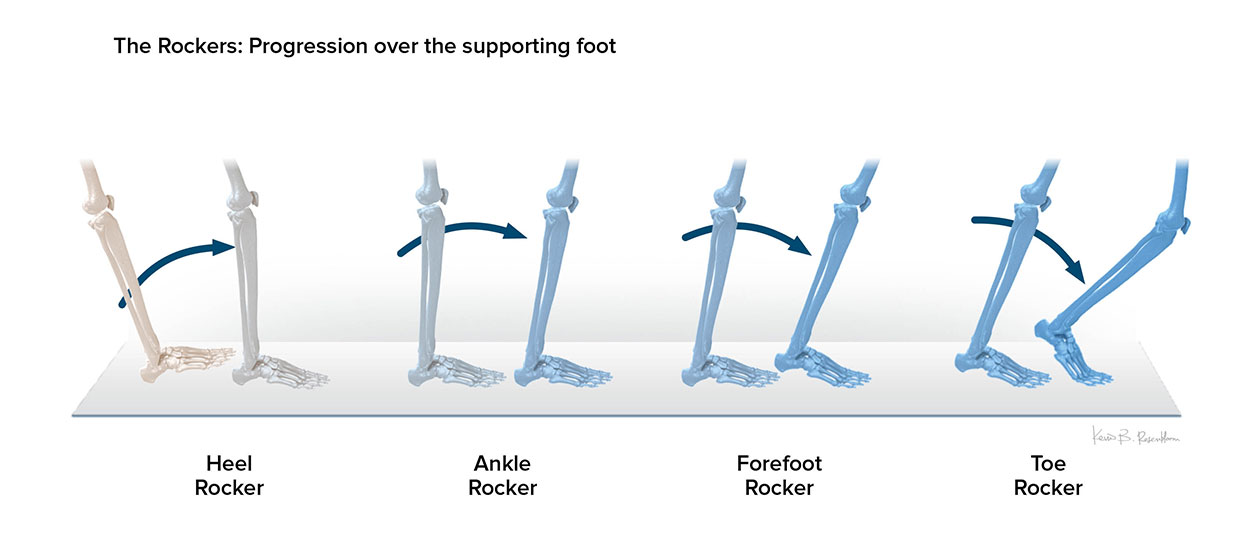I want to highlight this article by Okita and Meyers, et al, from 2013 on Midtarsal Joint Locking. We have all learned that foot pronation in the early stages of gait makes the foot a mobile adapter to the ground.This is due to the looseness it creates in the foot when the subtalar joint pronates. We also have learned that subtalar joint supination can lock the midtarsal joints in late midstance and early propulsion giving rigidity to the foot for a solid pushoff. I ask all of you to grab the nearest foot to you and move the midfoot from 3 positions and observe the change in mobility. The first is to place the subtalar joint in its middle range of motion, or subtalar neutral if you can find it. Feel the range of motion as you dorsiflex and plantarflex the midfoot around a fixed subtalar joint. Second, place the subtalar joint maximally pronated. You will see that that range of motion increases. Third, place the subtalar joint maximally supinated and feel the loss of this range of motion. Subtalar pronation allows the midtarsal joint to help in foot adaptation, and subtalar joint supination allows the midtarsal joint to be rigid for a powerful push off. Yes, I know you know this. It is the concept of locking that has people baffled and what this article attempts to explore.
Midtarsal joint locking: New perspectives on an old paradigm

This article starts with the concept that we all accept: the foot goes through an initial weight bearing flexibility, and then becomes rigid for pushoff. They surmise that the flexibility comes from joint uncoupling and rigidity with joint coupling. Joint uncoupling means that the bones across a joint move independently and they are mainly describing the talus, navicular, calcaneus and cuboid. This has never been taught, joint uncoupling would be terribly pathologic and the result of injury. Minor joint uncoupling is joint subluxation aka joint dysfunction. Major joint uncoupling means dislocation. They also thought that midtarsal joint locking would only occur if there were no joint rotations during that time. With the subtalar joint constantly moving into more and more subtalar joint supination directions, during the time the midtarsal joint is achieving rigidity for locking, this premise would also have to be incorrect.
I have to look back at my notes from a talk from our esteemed Biomechanics expert, our own CCPM Dr. Eric Fuller where he says the physics definition of joint coupling is merely when two systems are interacting with each other. From this definition, healthy foot joints moving are always coupled across the two bones in the joint and in relationship to surrounding joints. In fact, all of the joints in the lower extremities work in a synchronized manner that can only be considered coupled. However, there is literature that does imply that anatomical joint uncoupling is almost synonymous with joint flexibility and joint coupling synonymous with joint rigidity. Therefore, I see where the authors went astray. I feel like Dr. Fuller, that just because the subtalar joint pronates and loosens up the rest of the foot, that the joints in the foot stay coupled and non-pathological in the first half of the stance phase when it should be happening.
Yet, what did they conclude after doing their study? They agreed that no such joint uncoupling occurred during a step! Hooray! They looked at the rotational motions of the 4 joints involved in the midtarsal joint: talo-navicular, calcaneocuboid, cubonavicular, and talo-calcaneal. The first 20% of the gait cycle involved rapid eversion of the joints involved, the middle of a step (20-70%) has a relative calm of activity, and the final 30% (marked by midtarsal joint inversion) has a rapid increase in motion in the two talar joints, and only slight motion in the two cuboid joints. Talar inversion started at 20% and continued until toe off. Even though all joints continuously move during a step, this relative stability coming from the cuboid move than the talus appears to be a “locking mechanism”. If any of you read this article, I would be curious about your thoughts.
Rich






